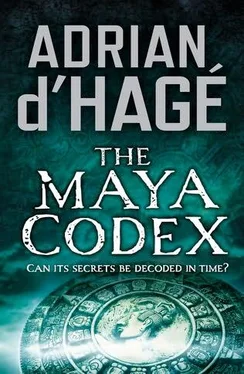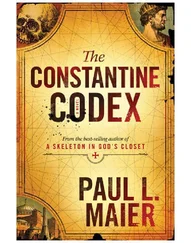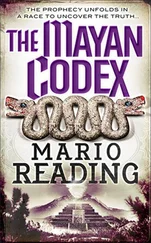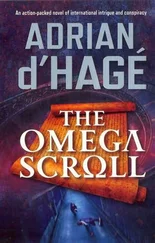Adrian D'Hage - The Maya codex
Здесь есть возможность читать онлайн «Adrian D'Hage - The Maya codex» весь текст электронной книги совершенно бесплатно (целиком полную версию без сокращений). В некоторых случаях можно слушать аудио, скачать через торрент в формате fb2 и присутствует краткое содержание. Жанр: Политический детектив, на английском языке. Описание произведения, (предисловие) а так же отзывы посетителей доступны на портале библиотеки ЛибКат.
- Название:The Maya codex
- Автор:
- Жанр:
- Год:неизвестен
- ISBN:нет данных
- Рейтинг книги:3 / 5. Голосов: 1
-
Избранное:Добавить в избранное
- Отзывы:
-
Ваша оценка:
- 60
- 1
- 2
- 3
- 4
- 5
The Maya codex: краткое содержание, описание и аннотация
Предлагаем к чтению аннотацию, описание, краткое содержание или предисловие (зависит от того, что написал сам автор книги «The Maya codex»). Если вы не нашли необходимую информацию о книге — напишите в комментариях, мы постараемся отыскать её.
The Maya codex — читать онлайн бесплатно полную книгу (весь текст) целиком
Ниже представлен текст книги, разбитый по страницам. Система сохранения места последней прочитанной страницы, позволяет с удобством читать онлайн бесплатно книгу «The Maya codex», без необходимости каждый раз заново искать на чём Вы остановились. Поставьте закладку, и сможете в любой момент перейти на страницу, на которой закончили чтение.
Интервал:
Закладка:
‘Not the only storm brewing,’ O’Connor replied. ‘The Iranians have just test-fired another Sejil-2 missile.’ In the two weeks since O’Connor had arrived at Gakona, a camaraderie had developed between the two men. Both had strong scientific backgrounds, both were cleared to the highest levels of security, and both were serving their country amidst the privations of the harsh conditions of Alaska.
‘Have a look at this.’ O’Connor rebooted the satellite images showing a powerful twenty-six-tonne missile rising majestically into the Iranian night sky from its launch pad at the missile test site at Semnan, outside of Tehran.
‘They’ve come a long way in a very short time,’ Jackson agreed. ‘Their next step will be a three-stage motor… which will put cities like Rome and London in reach.’
O’Connor nodded. ‘It may not be that far off, when you consider their first space launch – you could see bits and pieces falling off the rocket as it left the launch pad – yet barely a year later they’ve got a satellite into a stable orbit.’
‘You think they’re getting help? I’ve been a bit out of the loop up here.’
‘I know they’re getting help. I’ve seen the reports from one of our agents inside Iran. For starters, they needed maraging steel for the missile casing. That’s a low-carbon, ultra-high-strength steel that’s critical for low-weight missile skins. It’s a controlled item under international agreements, but the Iranians have managed to buy it; so someone’s selling. The tungsten copper alloy bars they needed for their solid-propellant control vanes are also a prohibited item, but somehow they’ve managed to get hold of them as well… probably out of China.’
‘Why the tungsten alloy?’
‘Solid propellant exhaust contains aluminium oxide, which is extremely abrasive,’ O’Connor explained, ‘but the Iranians have designed jet vanes that can withstand the entire sixty-second burn of the first stage of the rocket. If they can overcome the problems of an external heat shield and they develop a nuclear warhead, the balance of power in the world is going to change dramatically.’
‘You think they’re getting close?’
O’Connor nodded. ‘The reports we’re getting out of Iran indicate they’re constructing a new uranium enrichment plant near the old city of Qom, but it’s buried so deep into solid rock it will be almost impossible to attack, at least with ordinary bombs. The Pentagon is developing what it’s dubbed a “massive ordnance penetrator” that contains thousands of kilograms of explosives. It’ll be delivered by the stealth bomber, but even that may not be enough to deal with blast doors that are deep underground.’
‘Which probably explains the pressure we’re now under to fast-track our experiments here,’ Jackson said grimly, ‘which is madness.’
‘Dangerous?’
‘The science is untested, which is reason enough to be cautious.’
‘Try telling that to the Vice President.’
‘Exactly. Or some of the gung-ho brass in the Pentagon. Have you seen the proposals for Operation Aether?’
‘Not the detail.’
‘It’s in three phases. The first involves a burst of three billion watts to heat and raise the ionosphere, to see if we can deflect a missile off course, and the last phase aims to develop ways of controlling the weather, which the military have been trying to do since Vietnam. But as dangerous as those experiments might be, it’s the second phase that worries me most.’ Jackson loaded a thumb drive into the computer on O’Connor’s desk and fired up a PowerPoint presentation. It was headed ‘Top Secret’.
‘The second phase involves the generation of extremely low frequency, or ELF, waves directed at the earth’s core, rather like the way the mining industry uses seismic tomography to search for deposits of oil and natural gas.’
‘But the mining industry only uses power of about thirty to forty watts?’
‘Precisely. At higher power levels we know we can X-ray the ground, and that can be useful in providing imagery on tunnels and bunkers, but the Pentagon wants to know if we can generate power levels at the extreme end of the range that can actually destroy underground installations – Iran’s nuclear facilities being high on their list.’
O’Connor let out a low whistle. ‘Are we seriously thinking of bombarding the earth’s core with three billion watts?’
‘There are powerful forces in Washington who are determined to see if it will work, and I’m afraid the director is just a puppet who’ll do as he’s told. Are you familiar with the Chandler wobble?’
O’Connor nodded. In 1891 an American astronomer, Seth Carlo Chandler, discovered that the earth wobbled on its axis by up to fifteen metres.
‘Well,’ Jackson continued, ‘a highly respected Indian seismologist has pointed to data from the International Earth Rotation Service. In the three months leading up to the devastating earthquakes and tsunamis of 2004, the Chandler wobble increased significantly. Normally we might get one earthquake a year above seven on the Richter scale – what we call a “great earthquake” – but in 2004 there was a massive earthquake in the Macquarie Trench off New Zealand on 23 December, and that one measured 8.1. Just three days later, we had an even bigger earthquake… around nine if I remember correctly… triggering the tsunamis that killed hundreds of thousands on the coasts of Asia. The frequency of those great earthquakes is increasing, and the Chandler wobble is maintained by mass distribution within the molten outer core, as well as the crust and oceans.’
‘So if we start bombarding the core with billions of watts of electromagnetic energy… ’
‘We might generate an even greater wobble. It’s madness, but the admirals and the generals aren’t listening.’
‘Neither are the politicians. Is there any other data to connect the wobble with the frequency of earthquakes?’
‘In 1967 two Canadian scientists came up with the Mansinha-Smylie theory connecting the earth’s wobble with the big earthquakes, but mainstream science has largely ignored it. And it gets worse.’ Jackson turned to one of the centre’s computers, keyed in a series of commands and pulled up an extraordinary photograph taken from the Hubble telescope. The space shuttle Discovery had carried the eleven-tonne Hubble into orbit in 1990. Bigger than a truck, the telescope orbited the earth every ninety-seven minutes. ‘At a height of 360 kilometres, Hubble is free of any of the distortions of the earth’s atmosphere, which enables us to take very clear photographs of some of the most distant objects in the universe. That’s the galaxy NGC 1300, which in the scheme of things is actually quite close. It’s about sixty-nine million light years away from earth, and 88 000 light years in diameter.’
O’Connor stared at the stunning image of the barred spiral galaxy, a massive swirling red-and-blue catherine-wheel in the Eridanus constellation. ‘Huh. Eighty-eight thousand light years wide… big doesn’t seem to do it justice.’
Jackson grinned. ‘No, and that’s especially so when you think about the size of the universe. There are somewhere between 200 and 400 billion stars in our Milky Way galaxy alone. Multiply that by another 200 billion galaxies in the cosmos, and size is difficult to picture. With trillions of planets out there, it’s absurd to think that earth is the only one with life on it, but I’ve chosen a photograph of the NGC 1300 galaxy because it’s similar to our own and its centre is clearly visible.’ Jackson pointed to the swirling image on the screen. ‘The centre is a black hole of unimaginable gravitational and electromagnetic energy.’
‘It looks flat – almost like a disc.’
Читать дальшеИнтервал:
Закладка:
Похожие книги на «The Maya codex»
Представляем Вашему вниманию похожие книги на «The Maya codex» списком для выбора. Мы отобрали схожую по названию и смыслу литературу в надежде предоставить читателям больше вариантов отыскать новые, интересные, ещё непрочитанные произведения.
Обсуждение, отзывы о книге «The Maya codex» и просто собственные мнения читателей. Оставьте ваши комментарии, напишите, что Вы думаете о произведении, его смысле или главных героях. Укажите что конкретно понравилось, а что нет, и почему Вы так считаете.











